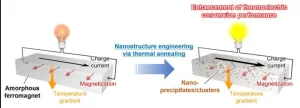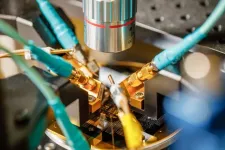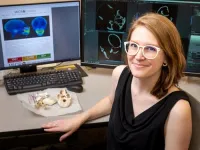Transforming common soft magnets into a next-generation thermoelectric conversion materials by 3 minutes heat treatment
A new direction in material development for transverse thermoelectric conversion using magnetic materials
2024-05-10
(Press-News.org) 1. A research team from NIMS and Nagoya University has demonstrated that an iron-based amorphous alloy, widely used as a soft magnetic material in transformers and motors, can be transformed into a "transverse" thermoelectric conversion material that converts electric and thermal currents in orthogonal directions, with just a short period of heat treatment. This is the first example that highlights the importance of microstructure engineering in the development of transverse thermoelectric conversion materials, and provides new design guidelines for materials development to realize environmentally friendly power generation and thermal management technologies using magnetic materials.
2. The use of transverse thermoelectric effects in magnetic materials is expected to simplify the structure of thermoelectric conversion devices compared to the longitudinal thermoelectric effects, where electric and thermal currents are converted in parallel directions. This simplification can lead to enhanced versatility and durability of the devices, as well as cost reduction. The main focus of the development of magnetic materials for transverse thermoelectric conversion has been the exploration of new alloys based on electronic structure, with no research on the microstructure within the materials.
3. The team has now demonstrated that a simple three-minutes heat treatment of an iron-based amorphous alloy, without changing the average composition of the material, significantly improves the performance of the anomalous Nernst effect—one of the transverse thermoelectric effects. The anomalous Nernst coefficient, obtained at the optimal heat treatment temperature, showed the highest value known among magnetic amorphous alloys, and the improvement was found to be significantly influenced by nano-sized copper precipitates within the alloy. This result suggests that not only the electronic structure and composition of the material but also the design and control of the microstructure are important for enhancing the anomalous Nernst coefficient.
4. The developed magnetic material can be easily mass-produced and scaled up, and it is also flexible. By further developing magnetic materials with even higher anomalous Nernst coefficients through microstructure control, the team aims to apply this technology to energy conversions in electronic devices and to thermal sensing technologies.
***
5. This research was conducted by Postdoctoral Researcher Ravi Gautam, Researcher Takamasa Hirai, Deputy Center Director Tadakatsu Ohkubo, Distinguished Group Leader Ken-ichi Uchida, Group Leader Hossein Sepehri Amin at NIMS Magnetic and Spintronics Materials Research Center, Designated Assistant Professor Abdulkareem Alasli and Professor Housei Nagano from Nagoya University, as part of the JST Strategic Basic Research Programs ERATO "Uchida Magnetic Thermal Management Materials Project" (Research Director: Ken-ichi Uchida, Grant Number: JPMJER2201).
6. The results of this study were published online in the journal Nature Communications at 19:00 Japan time on March 27, 2024.
END
[Attachments] See images for this press release:

ELSE PRESS RELEASES FROM THIS DATE:
2024-05-09
What if your earbuds could do everything your smartphone can do already, except better? What sounds a bit like science fiction may actually not be so far off. A new class of synthetic materials could herald the next revolution of wireless technologies, enabling devices to be smaller, require less signal strength and use less power.
The key to these advances lies in what experts call phononics, which is similar to photonics. Both take advantage of similar physical laws and offer new ways to advance technology. While photonics takes advantage of photons – or light – phononics does the same with phonons, which are the physical particles that transmit mechanical vibrations ...
2024-05-09
PHILADELPHIA (May 9, 2024) – New research from Penn Nursing’s Center for Health Outcomes and Policy Research (CHOPR) – recently published online in the journal Research in Nursing & Health – has successfully validated a new, streamlined version of the Practice Environment Scale of the Nursing Work Index (PES-NWI), originally authored in 2002 by Eileen T. Lake, PhD, RN, FAAN, Professor of Nursing, the Edith Clemmer Steinbright Professor in Gerontology, and Associate Director of CHOPR, who is also lead author on this publication. This innovative tool, known as the PES-5, is designed to revolutionize how nurse work environments are measured across ...
2024-05-09
As the U.S. Environmental Protection Agency cracks down on insidious “forever chemical” pollution in the environment, military and commercial aviation officials are seeking ways to clean up such pollution from decades of use of fire suppressant foams at military air bases and commercial airports.
Fire-suppression foams contain hundreds unhealthful forever chemicals, known by chemists as PFAS or poly- and per-fluoroalkyl substances. These compounds have stubbornly strong fluorine-to-carbon bonds, which allow them to persist indefinitely in the environment, hence the moniker “forever chemicals.” ...
2024-05-09
UC Riverside astrophysicist Stephen Kane had to double check his calculations. He wasn’t sure the planet he was studying could be as extreme as it seemed.
Kane never expected to learn that a planet in this faraway star system is covered with so many active volcanoes that seen from a distance it would take on a fiery, glowing-red hue.
“It was one of those discovery moments that you think, ‘wow, it’s amazing this can actually exist,” Kane said. A paper detailing the discovery has been published in The Astronomical Journal.
Launched in 2018, NASA’s Transiting Exoplanet Survey ...
2024-05-09
DURHAM, N.C. – A team led by the Duke Human Vaccine Institute (DHVI) has developed a vaccine approach that works like a GPS, guiding the immune system through the specific steps to make broadly neutralizing antibodies against HIV.
Publishing in the journal Cell Host & Microbe, the study describes an approach that provides step-by-step directions for the immune system to generate the elusive, yet necessary antibodies for a successful HIV vaccine.
“HIV is the fastest-evolving virus known. So it’s been a long-standing goal in HIV research to create ...
2024-05-09
The National Science Foundation awarded $630,444 to Kathleen Paul, an assistant professor of anthropology at the U of A, to provide a comprehensive outline of dental genetic architecture for two primate species of tamarins and macaques.
Paul's research team’s ultimate goal is to harness this information to advance bioanthropological practice, including the use of teeth for reconstructing evolutionary processes and experiences of stress and illness.
No live animals will be used in the research. Instead, skeletonized individuals from collections ...
2024-05-09
Discrimination may speed up the biological processes of aging, according to a new study led by researchers at the NYU School of Global Public Health.
The research links interpersonal discrimination to changes at the molecular level, revealing a potential root cause of disparities in aging-related illness and death.
“Experiencing discrimination appears to hasten the process of aging, which may be contributing to disease and early mortality and fueling health disparities,” said Adolfo Cuevas, assistant professor in the Department of Social and Behavioral Sciences at NYU’s ...
2024-05-09
COLUMBUS, Ohio – Systems controlled by next-generation computing algorithms could give rise to better and more efficient machine learning products, a new study suggests.
Using machine learning tools to create a digital twin, or a virtual copy, of an electronic circuit that exhibits chaotic behavior, researchers found that they were successful at predicting how it would behave and using that information to control it.
Many everyday devices, like thermostats and cruise control, utilize linear controllers – which use ...
2024-05-09
University of Leeds news release
Embargoed until 1900 BST, 9 May 2024
How climate change will affect malaria transmission
A new model for predicting the effects of climate change on malaria transmission in Africa could lead to more targeted interventions to control the disease according to a new study.
Previous methods have used rainfall totals to indicate the presence of surface water suitable for breeding mosquitoes, but the research led by the University of Leeds used several climatic and hydrological models to include real-world processes of evaporation, infiltration and flow through rivers.
This ...
2024-05-09
Machine learning enables cheaper and safer low-power magnetic resonance imaging (MRI) without sacrificing accuracy, according to a new study. According to the authors, these advances pave the way for affordable, patient-centric, and deep learning-powered ultra-low-field (ULF) MRI scanners, addressing unmet clinical needs in diverse healthcare settings worldwide. Magnetic Resonance Imaging (MRI) has revolutionized healthcare, offering noninvasive and radiation-free imaging. It holds immense promise for advancing medical diagnoses through artificial intelligence. However, despite its five decades of development, MRI remains largely inaccessible, particularly ...
LAST 30 PRESS RELEASES:
[Press-News.org] Transforming common soft magnets into a next-generation thermoelectric conversion materials by 3 minutes heat treatment
A new direction in material development for transverse thermoelectric conversion using magnetic materials





